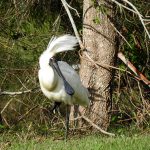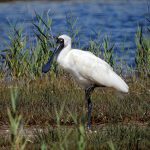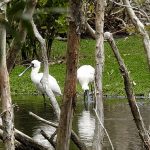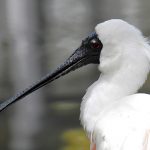ROYAL SPOONBILL
Royal Spoonbills are easily recognizable due to their striking appearance. They have long legs and a tall, slender body. The most distinctive feature is their bill, which is long and flattened at the tip, resembling a spoon. During the breeding season, adults develop distinctive plumage, with a white body, black legs, and a patch of yellow skin at the base of the neck. They also have a crest of long, white feathers on the back of their heads.
Royal Spoonbills are found in various wetland habitats in Australia and New Zealand. They are known to inhabit coastal areas, estuaries, lagoons, and inland freshwater wetlands.
These birds are typically seen foraging in shallow water, sweeping their spoon-shaped bills from side to side to catch aquatic invertebrates, small fish, and crustaceans. They often feed in groups, making synchronized movements to herd prey.
Royal Spoonbills breed in colonies, usually in trees or shrubs near water. They build stick nests lined with grass and other vegetation. Breeding season varies depending on the region but typically occurs from late winter to early summer. They lay a clutch of 2-4 eggs, which are incubated by both parents.
Royal Spoonbills face habitat loss and degradation due to human activities, such as wetland drainage and development, which can impact their breeding and foraging habitats.
In Australia, Royal Spoonbills can be confused with Yellow-billed Spoonbills, which have a yellowish bill. However, the Royal Spoonbill’s black legs and distinctive plumage differences help distinguish the two species.
Royal Spoonbills are fascinating birds known for their unique appearance and behavior. They are a valuable part of the wetland ecosystems they inhabit and are enjoyed by birdwatchers and nature enthusiasts.





